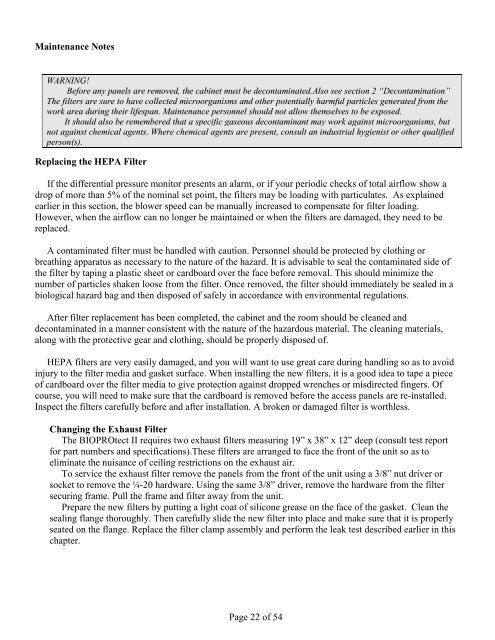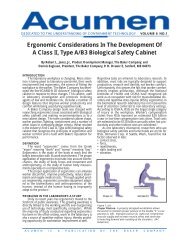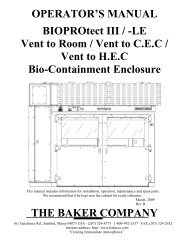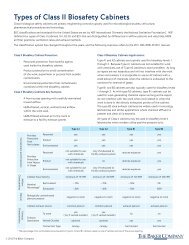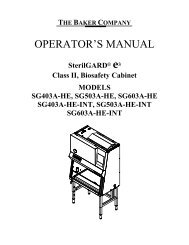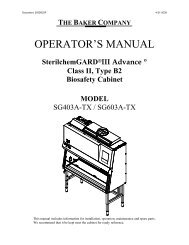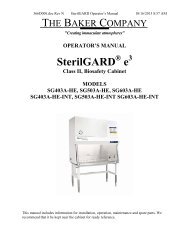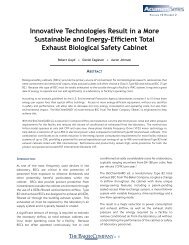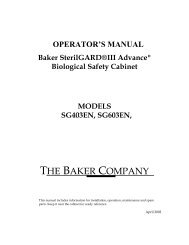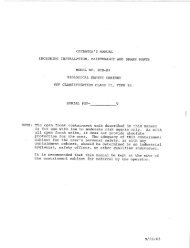OPERATOR'S MANUAL BIOPROtect II Vent to ... - Baker Company
OPERATOR'S MANUAL BIOPROtect II Vent to ... - Baker Company
OPERATOR'S MANUAL BIOPROtect II Vent to ... - Baker Company
Create successful ePaper yourself
Turn your PDF publications into a flip-book with our unique Google optimized e-Paper software.
Maintenance NotesWARNING!Before any panels are removed, the cabinet must be decontaminated.Also see section 2 “Decontamination”The filters are sure <strong>to</strong> have collected microorganisms and other potentially harmful particles generated from thework area during their lifespan. Maintenance personnel should not allow themselves <strong>to</strong> be exposed.It should also be remembered that a specific gaseous decontaminant may work against microorganisms, butnot against chemical agents. Where chemical agents are present, consult an industrial hygienist or other qualifiedperson(s).Replacing the HEPA FilterIf the differential pressure moni<strong>to</strong>r presents an alarm, or if your periodic checks of <strong>to</strong>tal airflow show adrop of more than 5% of the nominal set point, the filters may be loading with particulates. As explainedearlier in this section, the blower speed can be manually increased <strong>to</strong> compensate for filter loading.However, when the airflow can no longer be maintained or when the filters are damaged, they need <strong>to</strong> bereplaced.A contaminated filter must be handled with caution. Personnel should be protected by clothing orbreathing apparatus as necessary <strong>to</strong> the nature of the hazard. It is advisable <strong>to</strong> seal the contaminated side ofthe filter by taping a plastic sheet or cardboard over the face before removal. This should minimize thenumber of particles shaken loose from the filter. Once removed, the filter should immediately be sealed in abiological hazard bag and then disposed of safely in accordance with environmental regulations.After filter replacement has been completed, the cabinet and the room should be cleaned anddecontaminated in a manner consistent with the nature of the hazardous material. The cleaning materials,along with the protective gear and clothing, should be properly disposed of.HEPA filters are very easily damaged, and you will want <strong>to</strong> use great care during handling so as <strong>to</strong> avoidinjury <strong>to</strong> the filter media and gasket surface. When installing the new filters, it is a good idea <strong>to</strong> tape a pieceof cardboard over the filter media <strong>to</strong> give protection against dropped wrenches or misdirected fingers. Ofcourse, you will need <strong>to</strong> make sure that the cardboard is removed before the access panels are re-installed.Inspect the filters carefully before and after installation. A broken or damaged filter is worthless.Changing the Exhaust FilterThe <strong>BIOPROtect</strong> <strong>II</strong> requires two exhaust filters measuring 19” x 38” x 12” deep (consult test reportfor part numbers and specifications).These filters are arranged <strong>to</strong> face the front of the unit so as <strong>to</strong>eliminate the nuisance of ceiling restrictions on the exhaust air.To service the exhaust filter remove the panels from the front of the unit using a 3/8” nut driver orsocket <strong>to</strong> remove the ¼-20 hardware. Using the same 3/8” driver, remove the hardware from the filtersecuring frame. Pull the frame and filter away from the unit.Prepare the new filters by putting a light coat of silicone grease on the face of the gasket. Clean thesealing flange thoroughly. Then carefully slide the new filter in<strong>to</strong> place and make sure that it is properlyseated on the flange. Replace the filter clamp assembly and perform the leak test described earlier in thischapter.Page 22 of 54


